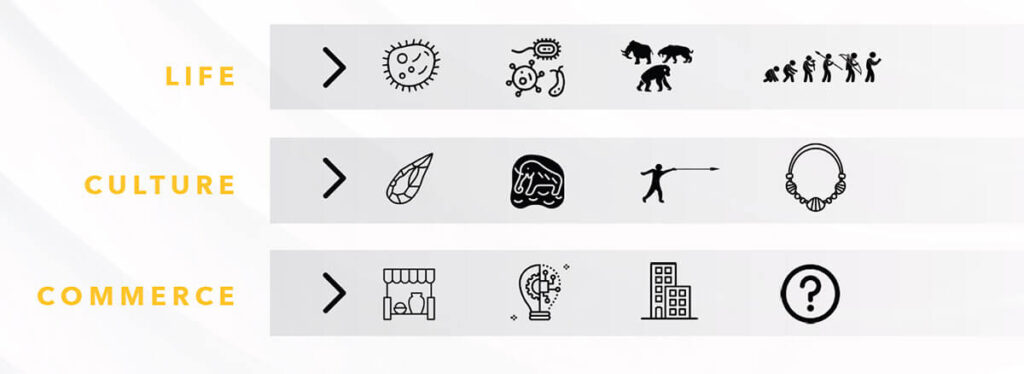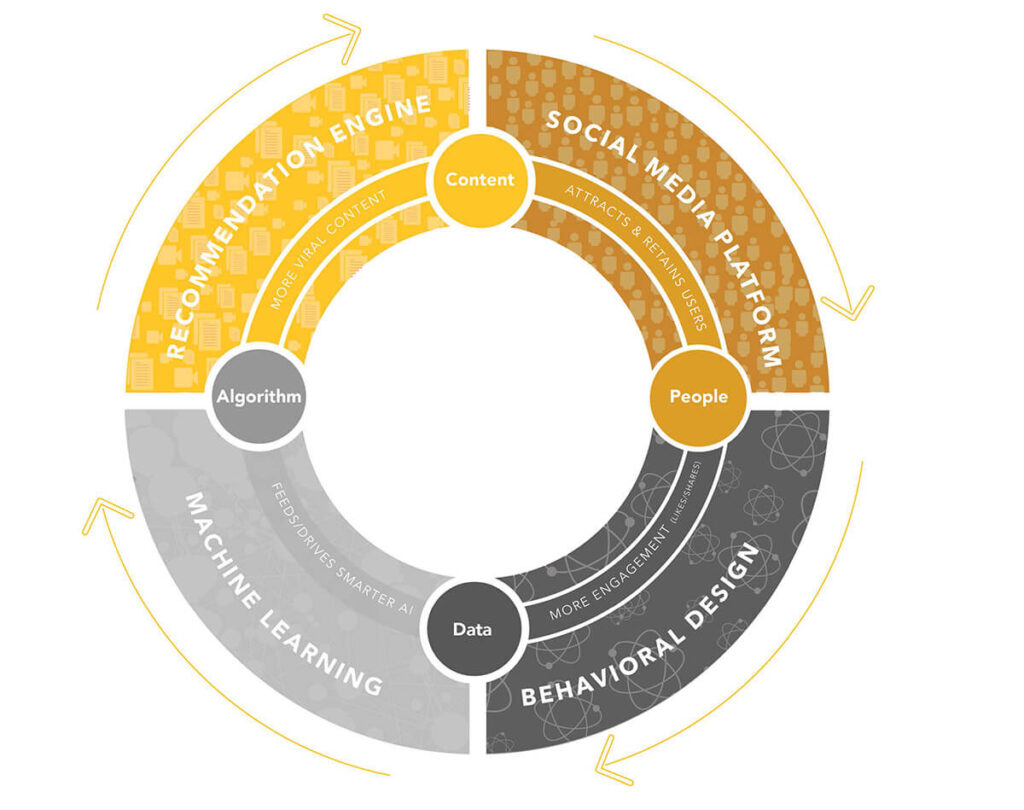To download a designed PDF of this report click here.
The engine of adaptation
Innovation is a biological truth dating back to the evolution of the first organisms—the original engine of adaptation.
Through the development of culture and invention, early humans sparked a chain reaction that enabled ever-increasing quality of life. But with innovation now embedded in the heart of business and society, our engine of adaptation is reaching a critical point.
The Engines
Engines of adaptation, the evolutionary algorithm (variation -> selection -> adaptation), have played out across biological life, human culture, and now, most recently, through business innovation. In each case, cooperative prosocial behavior has been at the heart of competitive advantage.

According to Tamim Ansary, author of The Invention of Yesterday, our human capacity for innovation is inevitable. “Anything that can be invented,” he says, “will be invented.”
Over time, invention overtook evolution, but more than just an adaptive mechanism for survival; it became a competitive advantage. With higher rates of global adoption, innovations are accelerating at such a fast pace that it has become critical to course-correct potential mistakes before they become unintended consequences. Enter Purposeful Innovation.
As the next wave of frontier tech—Web3, AR/VR/XR, robotics, and more—emerges on a global scale, we need to focus less myopically on human needs and wants, and more holistically on a new kind of design.

Turning ‘me’ into ‘we’
Silicon Valley has been at the forefront of innovation for over half a century. Human-Centered Design (HCD) found its start in the Valley and slowly defined the way nearly every company innovates decades ahead of the pack.
As a result, we’ve long held the belief that HCD is intrinsically humane as it strives to address consumer needs. But we’ve mistaken human need for human good.
HCD defined digital product development, including social media—which most of the global population now uses daily. Without holistic thinking, we failed to anticipate the consequences of connecting billions of people. In 2013, when religious violence broke out in Myanmar, Facebook was shut down for several days. This led to a decrease in violence, giving us a unique view into the impacts of social platforms. Across the world, we have seen the consequences of algorithmic mass engagement, further polarizing our political system.
Attempting to fix something in advance of an actual calamity seems fanciful to many innovators, anchored in the “move fast and break things” ethos. But we are optimistic. Investors, consumers and regulators have spoken: innovation with no foresight and guardrails for ethical implications is not acceptable. It’s time to change the paradigm.
Algorithmic mass engagement
Social networks evolved into social media as behavioral design combined with machine learning identified and spread the most engaging content. Massive amounts of data trained these algorithms to promote the most liked, shared, and viewed content, much of which over indexes on moral outrage, driving the race for mass engagement.

Move fast and break things is broken. Now let’s move smart to make good.
Visions of Innovation without Purpose
In 2010, Keiichi Matsuda, a London-based artist and filmmaker, produced a short film called Augmented (Hyper Reality: Domestic Robocop). Set in a technologically advanced future where everyone wears smart glasses, the film depicts the clash of commercial ads in our private domestic spaces. Advertisements and notifications pop up everywhere, consuming the physical world entirely. While the tv-series Black Mirror trope is overly dystopic and exaggerated, it provides us with a dire warning about innovation without purpose. If we miss the purpose of advertising – to make us aware of new products that meet unmet needs – we run the risk of maximizing a short-term metric while missing the underlying intent.
Shifting the design paradigm
Introducing: humane holistic design
By using humane and holistic as new parameters for innovation, we open possibilities. We reimagine shareholder capitalism to include all stakeholders. We transition beyond market trends to create new markets for Purposeful products. We change from “move fast and break things” in order to move smart and learn things. All this and more so we ensure that emerging technologies are ethical technologies.
Why humane?
Humane enables us to think beyond just the human being. It forces us to think about how we are part of interconnected ecosystems and challenges us to understand how one invention can impact society, the world, and the universe. We move beyond Jobs’ mantra to ‘leave a dent in the universe,’ and instead, leave the universe better than we found it.
Why holistic?
There’s a customer at the end of every B2B2B… chain, an environmental impact behind the raw materials and energy we use, and a social consequence to growth strategies. As we continue to invent new technologies at breakneck speed, we need to grasp how they will play out across second and third-order effects.

The evolution of competitive advantage
New technologies and methods drive organizations forward in the race for value creation and capture. Martin Reeves, Chairman of the BCG Henderson Institute, writes on the role of reimagination as a core component of modern business in The Imagination Machine. But beyond creating an open and innovative company culture, even more important is harnessing the spirit of the founding ethos. Which brings us to the juncture of Innovation on Purpose.
Organizational Purpose embodies a company’s reason for being, leveraging its distinctive strengths for a timeless need in the world. As generational shifts show a greater appetite for corporate social responsibility, consumers, employees, and investors are helping transform organizational priorities from profit motives to purpose motives. However, there’s a critical gap between articulating Purpose and bringing it to life.

Evolving how we stay competitive & innovative
Adaptation has always been critical for survival in an unpredictable environment. Fighter pilots have an approach to rapid adaptation in changing circumstances. Developed by United States Air Force Colonel John Boyd, the OODA loop is a strategic method to drive tactical, in-the-moment changes. OODA stands for Observe, Orient, Decide, Act. Although first applied to combat operations, the framework has utility in the rapidly changing, complex business environment. In a world reeling from disruption and a generational shift to purpose, companies must Observe, Orient, Design, and Act, in concert with processes to Test and Evaluate, to adapt and innovate on purpose and realize the new competitive advantage.

Flipping ‘good to great’ into ‘great to (greater) good’

Amy LaMeyer, Managing Partner at the WXR Fund, recognizes the role venture capital plays in the pipeline. “Humanity functions by crisis, to a certain extent,” she says. That is, we “fix it when it’s broken.” The titans of Silicon Valley are venture capitalists who amplify, accelerate, and ultimately choose the winners and losers through the companies they fund and founders they rally behind. Silicon Valley is also ground-zero for innovation practices. The ‘move fast and break things’ articulated by Facebook grew out of the start-up culture in the Valley.To change the trajectory of innovation, we need to embed humane and holistic parameters at the source by incorporating them into funding criteria. The question shouldn’t be what you’re innovating, but rather how, with whom, and ultimately why you’re innovating. Are you attracting diverse perspectives and people as future leaders and innovators? Is your approach ethical and prospective when it comes to intention and approach?
To fix the engine of adaptation that runs our future economy, we need to start in the Valley. Investors are key stakeholders in the innovation pipeline as they are responsible for not only boosting founders from concept to scale; they are a glimpse into our collective future. But because time is running out, we need to simultaneously bring the cure to the enterprise community.
Innovation on purpose
For the past 25 years, BCG BrightHouse has helped organizations uncover their deeper “why” through strategy and creative thinking. Now, we’re developing a new offering to lead the space on Innovation with Purpose.
Foresee the future consequences of present initiatives
Bruce Henderson, the founder of Boston Consulting Group, wrote on the concept of strategy itself as a phenomenon that sprung from “the ability to foresee the future consequences of present initiatives.”
Moving beyond HCD, we need to develop the next-generation methods, frameworks, and tools. Methods that allow us to look beyond human-centered and towards our deepest humane drives. Frameworks that stop focusing on the present product-market fit and look towards future possibilities to overcome unintended consequences.

Humane Holistic Design ensures that we innovate to bring light to the ways design thinking misses the mark. It also allows companies to operationalize their Purpose through innovation. So, as we continue to innovate, we must leverage new ways of thinking to power the engine of adaptation with Purpose.

It’s time to put purpose to work.
To download a designed PDF of this report click here.
Visuals created by Ed Rivero, Senior Designer, BCG BrightHouse